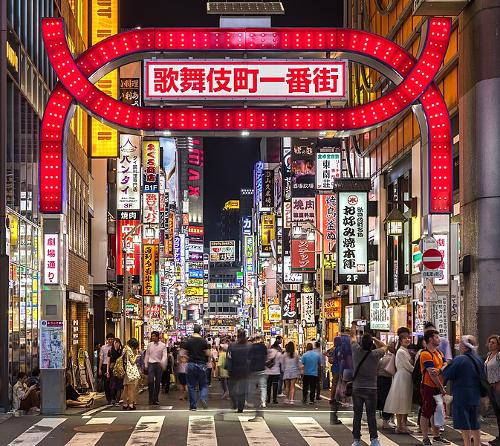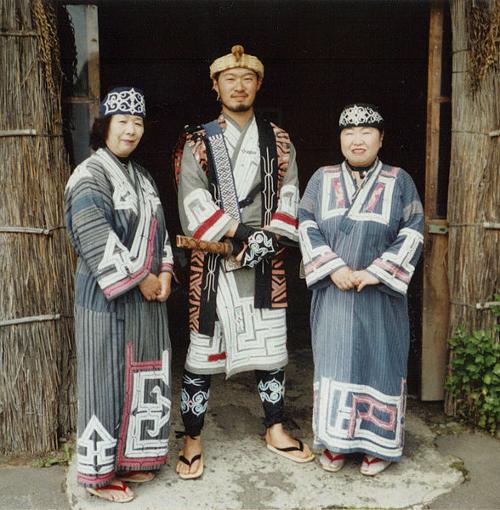JAPAN
Population

Population

Cities in JAPAN
| Kyoto | Osaka | Tokyo |
Population
General
 Densely populated Shinjuku district of Tokyo, JapanPhoto: Basile Morin CC 4.0 International no changes made
Densely populated Shinjuku district of Tokyo, JapanPhoto: Basile Morin CC 4.0 International no changes made
In 2024, Japan had aboutn123,202,000 million inhabitants, making it the twelth country in the world in terms of population. The population density then averaged about 335 inhabitants per km2, making Japan one of the most densely populated countries in the world.
Of the four major islands, Hokkaido has the lowest population density (68 inhabitants per km2) and Honshu the highest (421 inhabitants per km2). Shikoku has a population density of 225 inhabitants per km2 and Kyushu 317 inhabitants per km2. The urban conglomerations of Tokyo-Yokohama, Nagoya and Osaka-Kobe have an extremely high population density with more than 4000 inhabitants per km2. In 2024, more than 92% of the population lived in urbanized areas. Although Tokyo's population is declining, the city's conurbation is still growing. This trend can also be observed in Osaka. The largest cities are: Tokyo (population 7.9 million; agglomeration: 37 million), Osaka-Kobe 20.2 million, Nagoya 5.4 million, Fukuoka 2.9 million and Sapphoro 2.6 million. The mountain areas are the least populated.
No less than 98.5% of the total population is Japanese. Of the other non-Japanese population groups, the Ainoe and the Koreans are the most important. Very small foreign minorities are temporary workers from Southeast Asia, South America and Western countries.
After World War II, Japan was confronted with a population explosion, but government measures (contraception, possibility of abortion) successfully countered this development in the 1950s; the birth rate has been declining since 1960 (1993: 9.6 ‰). The population increased by an average of 0.4% between 1985 and 1993 (2024: -0.43%), which, given the low birth rate, is mainly due to the low mortality rate, which has been below 10 ‰ since 1951. The mortality rate in 2017 was 11.8 per 1000 inhabitants.
The Japanese have one of the highest life expectancies in the world: that of men averaged 82.3 years in 2017 and that of women 88.2 years.
The population breakdown in 2024 was as follows:
0-14 years: 12.1%
15-64 years: 58.4%
65+: 29.5%
Ainu
 Ainu with traditional clothing, JapanPhoto: Torbenbrinker CC 3.0 Unported no changes made
Ainu with traditional clothing, JapanPhoto: Torbenbrinker CC 3.0 Unported no changes made
Some scientists believe that the Ainu are descendants of the first inhabitants of Japan. They were initially nomadic tribes who lived off hunting and fishing in Central and Northern Japan. They were expelled by the peoples who set foot after them and had to retreat to the island of Hokkaido, where their culture has slowly been lost. Few Ainu can understand the Ainu language or have managed to preserve their traditional culture. Only some time ago ancient epics or "yukars" were written down. The Ainu religion is animist, in which it is believed that animals, trees and stones possess a spirit or soul. The bear in particular plays an important role in the Ainu religion and traditions.
Only 22,000 Ainu remain on Hokkaido Island. They are totally different from the rest of the Japanese population in appearance, culture and religion. For a long time, they were considered part of the Caucasian race, but recent research has revealed that certain Caucasian genes are completely missing. Siberia is now also referred to as a place of origin. In any case, they had a fair complexion, light eyes and blond hair. Today's Ainu are usually the result of a mixed marriage between a Japanese and an Ainu, and are therefore hardly distinguishable from real Japanese. It is estimated that there are only about 200 purebred Ainu left.
Burakumin
The Burakumin are "real" Japanese who used to practice professions such as leather workers, butchers and cadaverists. On most religious grounds they were considered unclean beings (Eta) and lived outside the traditional communities in isolated hamlets called "buraku". They were even given separate names so that they can be recognized to this day. Since the restoration of the monarchy in 1871, discrimination against this population group has been prohibited, but discriminatory practices appear to still exist. For example, a burakumin can almost forget a marriage outside his own population group and one does not accept burakumin in business; people are so superstitious that they believe it could negatively affect the entire company.
It is estimated that there are about 3 million people of Burakumin descent living in Japan at present.
Koreans
A group of about 650,000 Koreans (zai-nichi kankoku-jin) lives in Japan. They are mainly descendants of forced laborers who came to Japan voluntarily or forcibly between 1910 and 1945. This population group is also discriminated against and mixed marriages are almost non-existent. In fact, they are still considered foreigners.
Sources
Japan
Lonely Planet
Japan
Reader's Digest
Kamachi, N. / Culture and customs of Japan
Greenwood Press
Scott, D. / Japan
Van Reemst
Shelley, R. / Japan
Times Books
Somerwil, J. / Japan
Gottmer/Becht
Stefoff, R. / Japan
Chelsea House Publishers
CIA - World Factbook
BBC - Country Profiles
Copyright: Team The World of Info